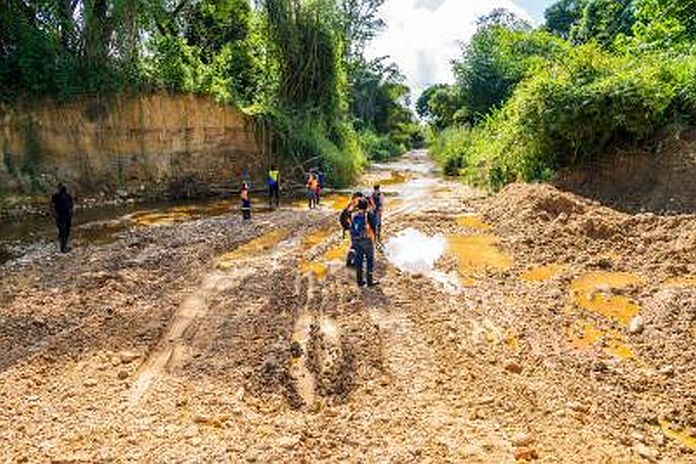PORT OF SPAIN, Trinidad, (News.Gov.tt) – Camille Robinson-Regis, minister of planning and development with responsibility for the environment has announced the Cabinet of ministers approval to rehabilitate 100 hectares of spent quarry lands by 2030 through community-based agroforestry, the rehabilitation of degraded forest and the increase of forest carbon stock by 5 percent by 2030, all relative to the baseline of 2015.
According to the minister, Cabinet has also agreed to:
- Improve productivity and Soil Organic Carbon (SOC) stocks in 500 hectares of cropland by 2030, compared to the 2015 baseline.
- Improve national data and develop a mechanism for the collection and management of land productivity, land cover and soil organic carbon (SOC) data for future monitoring needs.
- Achieve Land Degradation Neutrality (LDN) by 2030 with no net loss for the whole land area of the country and all its land cover, compared to the 2015 baseline.
This is to support Trinidad and Tobago’s Land Degradation Neutrality (LDN) goals, which is defined by the United Nations Convention to Combat Desertification (UNCCD) as ‘A state whereby the amount and quality of land resources, necessary to support ecosystem functions and services and enhance food security, remains stable or increases within specified temporal and spatial scales and ecosystems.
These goals are set to be accomplished partly through the use of remote sensing incorporating satellite data, in-field surveys and soil testing. It is important to note that these targets take into account necessary physical development and foreseeable land-use changes, intending to maintain the status of land resources at 2015 levels by the year 2030, with the goal of ensuring that Trinidad and Tobago should be no worse off in 2030 relative to 2015.
A review of data provided by the European Space Agency through the UNCCD Secretariat indicated that 58.3 percent of total land resources in Trinidad and Tobago are degraded when data for the years 2000 and 2015 were compared. This assessment is based on three main metrics being used to measure land quality which are vegetative cover, productivity and organic carbon content.
The ministry of planning and development finds this to be an alarming statistic because continuing down the current path of land degradation poses an imminent and significant threat for Trinidad and Tobago for three main reasons:
- Trinidad and Tobago is a Small Island Developing State (SIDS) which means land is a very finite resource, so its use must be sustainable and judicious; “If our land becomes degraded, it is not as though we can move on to another fresh productive piece of land because of our insular nature.” According to the Environmental Biologist of the ministry of planning environmental policy and planning division, Julius Smith.
- Land, specifically soil resources, is the basis for our terrestrial biodiversity and therefore underpins the agricultural sector and ecosystem services and products of Trinidad and Tobago.
- Thirdly, soils and vegetation are the most efficient (in terms of cost per tonne of carbon) and efficacious (with respect to the actual ability to store carbon per unit area/hectare) means of carbon sequestration and this has major implications for climate change adaptation and mitigation.
Smith also adds that our attitude towards land management requires a little bit of behavioural and attitudinal change because Trinidad and Tobago stand to reap significant benefits if Land Degradation Neutrality (LDN) is achieved by 2030, which includes the quality of our atmosphere and water resources being maintained at levels that would positively impact public health and the quality of life by significant margins. Lower incidence of respiratory and vector-borne diseases can lead to a reduction in demand for health care and decreased mortality. Food security can be improved from stabilized local food prices. Resilience to extreme weather events can be improved and lead to a reduction in flooding, landslides and associated road closures.
Opportunities for diversification of the national economy can also be enhanced. Land Degradation Neutrality envisions a world where human activity has a neutral, or even positive, impact on the land, and to facilitate this minister Robinson-Regis pledged the ministry of planning continuing mandate to place the environment at the centre of economic and social development as per Vision 2030’s theme 5, by preserving Trinidad and Tobago’s land and environmental resources through the advancement of a sustainable land management agenda across all sectors of our economy.
The government of Trinidad and Tobago remains committed to the UNCCD as part of our aim to achieve the Sustainable Development Goals; in this case climate action, and life on land; SDGs 13, and 15 respectively.
The minister also invites citizens to support conservation efforts by attaching themselves to any number of conservation initiatives which have direct linkages to land resources and biodiversity that are managed by the state, non-governmental organizations or community-based organizations.





